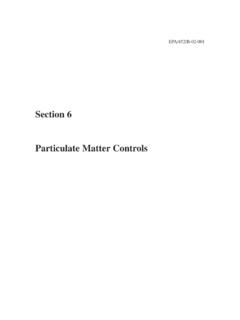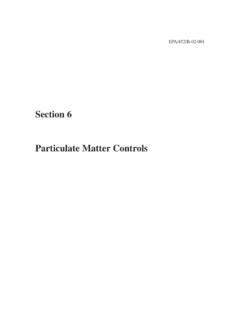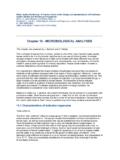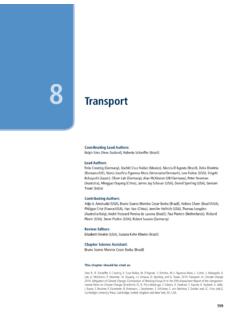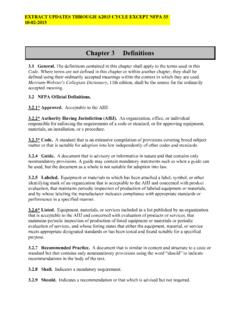Transcription of PT CHAPTER 5 PRODUCTION - European Commission
1 Ref. Ares(2015)283695 - 23/01/2015. PT CHAPTER 5 PRODUCTION . European Commission . HEALTH AND CONSUMERS DIRECTORATE-GENERAL. Health systems and products Medicinal products quality, safety and efficacy Brussels, 13 August 2014. EudraLex The Rules Governing Medicinal Products in the European Union Volume 4. EU Guidelines for Good Manufacturing Practice for Medicinal Products for Human and Veterinary Use Part 1. CHAPTER 3: Premises and Equipment Legal basis for publishing the detailed guidelines: Article 47 of Directive 2001/83/EC on the Community code relating to medicinal products for human use and Article 51 of Directive 2001/82/EC on the Community code relating to veterinary medicinal products.
2 This document provides guidance for the interpretation of the principles and guidelines of good manufacturing practice (GMP) for medicinal products as laid down in Directive 2003/94/EC. for medicinal products for human use and Directive 91/412/EEC for veterinary use. Status of the document: Revisiona. Reasons for changes: The only change is to section 6 as part of the improved guidance on prevention of cross-contamination involving also CHAPTER 5. Deadline for coming into operation: 1 March 2015. However, the toxicological evaluation mentioned in section 6 is to be carried out: from 1 June 2015 onwards for any medicinal product newly introduced into shared manufacturing facilities.
3 Before 1 December 2015 for medicinal products already produced in a shared manufacturing facility producing only medicinal products for human use or both producing medicinal products for human use and veterinary medicinal products on 31. May 2015;. before 1 June 2016 for veterinary medicinal products already produced in a shared manufacturing facility producing only veterinary medicinal products on 31 May 2015. a In January 2015 the deadline for coming into operation was adapted with regard to the toxicological evaluation to align with the coming effect of the EMA guideline on setting health based exposure limits for use in risk identification in the manufacture of different medicinal products in shared facilities.
4 Commission Europ enne, B-1049 Bruxelles / Europese Commissie, B-1049 Brussel Belgium. Telephone: (32-2) 299 11 11. ER 3 PREMISES AND EQUIPMENT. PRINCIPLE. Premises and equipment must be located, designed, constructed, adapted and maintained to suit the operations to be carried out. Their layout and design must aim to minimise the risk of errors and permit effective cleaning and maintenance in order to avoid cross-contamination, build-up of dust or dirt and, in general, any adverse effect on the quality of products. PREMISES. General Premises should be situated in an environment which, when considered together with measures to protect the manufacture, presents minimal risk of causing contamination of materials or products.
5 Premises should be carefully maintained, ensuring that repair and maintenance operations do not present any hazard to the quality of products. They should be cleaned and, where applicable, disinfected according to detailed written procedures. Lighting, temperature, humidity and ventilation should be appropriate and such that they do not adversely affect, directly or indirectly, either the medicinal products during their manufacture and storage, or the accurate functioning of equipment. Premises should be designed and equipped so as to afford maximum protection against the entry of insects or other animals. Steps should be taken in order to prevent the entry of unauthorised people.
6 PRODUCTION , storage and quality control areas should not be used as a right of way by personnel who do not work in them. PRODUCTION Area Cross-contamination should be prevented for all products by appropriate design and operation of manufacturing facilities. The measures to prevent cross-contamination should be commensurate with the risks. Quality Risk Management principles should be used to assess and control the risks. Depending of the level of risk, it may be necessary to dedicate premises and equipment for manufacturing and/or packaging operations to control the risk presented by some medicinal products. Dedicated facilities are required for manufacturing when a medicinal product presents a risk because: i.
7 The risk cannot be adequately controlled by operational and/ or technical measures, ii. scientific data from the toxicological evaluation does not support a controllable risk ( allergenic potential from highly sensitising materials such as beta lactams) or iii. relevant residue limits, derived from the toxicological evaluation, cannot be satisfactorily determined by a validated analytical method. 2. Further guidance can be found in CHAPTER 5 and in Annexes 2, 3, 4, 5 & 6. Premises should preferably be laid out in such a way as to allow the PRODUCTION to take place in areas connected in a logical order corresponding to the sequence of the operations and to the requisite cleanliness levels.
8 The adequacy of the working and in-process storage space should permit the orderly and logical positioning of equipment and materials so as to minimise the risk of confusion between different medicinal products or their components, to avoid cross- contamination and to minimise the risk of omission or wrong application of any of the manufacturing or control steps. Where starting and primary packaging materials, intermediate or bulk products are exposed to the environment, interior surfaces (walls, floors and ceilings) should be smooth, free from cracks and open joints, and should not shed particulate matter and should permit easy and effective cleaning and, if necessary, disinfection.
9 Pipework, light fittings, ventilation points and other services should be designed and sited to avoid the creation of recesses which are difficult to clean. As far as possible, for maintenance purposes, they should be accessible from outside the manufacturing areas. Drains should be of adequate size, and have trapped gullies. Open channels should be avoided where possible, but if necessary, they should be shallow to facilitate cleaning and disinfection. PRODUCTION areas should be effectively ventilated, with air control facilities (including temperature and, where necessary, humidity and filtration) appropriate both to the products handled, to the operations undertaken within them and to the external environment.
10 Weighing of starting materials usually should be carried out in a separate weighing room designed for such use. In cases where dust is generated ( during sampling, weighing, mixing and processing operations, packaging of dry products), specific provisions should be taken to avoid cross-contamination and facilitate cleaning. Premises for the packaging of medicinal products should be specifically designed and laid out so as to avoid mix-ups or cross-contamination. PRODUCTION areas should be well lit, particularly where visual on-line controls are carried out. In-process controls may be carried out within the PRODUCTION area provided they do not carry any risk to PRODUCTION .










